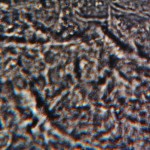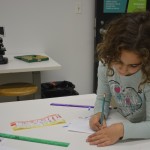We know that hands-on experimentation often leads to more meaningful learner engagement and a deeper understanding of concepts. We recently facilitated a catchy yet easy-to-execute experiment during drop-in hours in the BOOMbox, Skokie Public Library’s STEAM learning space. Our experiment: human DNA extraction.
While DNA extraction may seem daunting, this experiment is relatively simple and uses inexpensive household items. And we were even able to complete the experiment without a sink!
We used an experiment from NOVA as our starting point–it has a teacher resource sheet in addition to the printable experiment. Read the full experiment linked here for the step-by-step how-to; this post details how we set up the program.
In terms of preparation, printouts of the experiment were readily available for learners to follow along on their own, and copies were available for them to take to repeat the experiment at home. We already had many of the required supplies on hand, including dish soap, salt, and rubbing alcohol. And while we used plastic test tubes from our program materials stores, this experiment could be conducted using clear plastic cups, small glass jars, or another see-through container.
The BOOMbox does not have a sink, so for the sake of cleanliness we provided gloves for participants to wear (even though they were handling their own saliva). We had four plastic wash tubs on hand, with one as the ice bath for the rubbing alcohol and the others for waste. Staff cleaned everything at the end of the drop-in session.
 To further the learning experience, we encouraged learners who had successfully extracted their DNA to make their own microscope slides and view their samples on one of our LCD digital microscopes. This allowed the viewing experience to be social, rather than independent, as multiple participants could gather around a microscope screen to observe the DNA. Learners asked questions and hypothesized about what they could see.
To further the learning experience, we encouraged learners who had successfully extracted their DNA to make their own microscope slides and view their samples on one of our LCD digital microscopes. This allowed the viewing experience to be social, rather than independent, as multiple participants could gather around a microscope screen to observe the DNA. Learners asked questions and hypothesized about what they could see.
 We talked about DNA structure and who discovered it, and we used paper models in the BOOMbox to better understand what we were looking at and why the microscope didn’t show the double-helix structure. One way to help explain the glob of clearish goo that is cheek cell DNA is a spaghetti analogy. When you cook spaghetti, each strand is separate and visible in the pot of boiling water. But once you strain the spaghetti, the individual strands stick to one another and form a big jumbled ball of spaghetti. DNA behaves similarly in this experiment.
We talked about DNA structure and who discovered it, and we used paper models in the BOOMbox to better understand what we were looking at and why the microscope didn’t show the double-helix structure. One way to help explain the glob of clearish goo that is cheek cell DNA is a spaghetti analogy. When you cook spaghetti, each strand is separate and visible in the pot of boiling water. But once you strain the spaghetti, the individual strands stick to one another and form a big jumbled ball of spaghetti. DNA behaves similarly in this experiment.
Since this was a drop-in event, participation was unpredictable. But the BOOMbox is all about sharing knowledge. So as one participant finished the experiment, they were encouraged and often empowered to help the next.




Hi Amy! You beat me to the punch! Scientists/researchers from St. Jude’s Children’s Research Hospital came to my branch just a few days ago and did this very activity, among others, with the kids in my Crafternoon program. It was great! They also talked about genetic characteristics, and we were divided into groups according to the characteristics we exhibited, such as the ability to curl our tongues, whether or not our earlobes were attached, and what we could and could not taste. Interestingly, most of the folks in the group ended up on the same “branch” of the tree of genetics poster the scientists brought, despite the fact that several ethnic groups were represented. It was a lot of fun. I plan to repeat the program next summer.